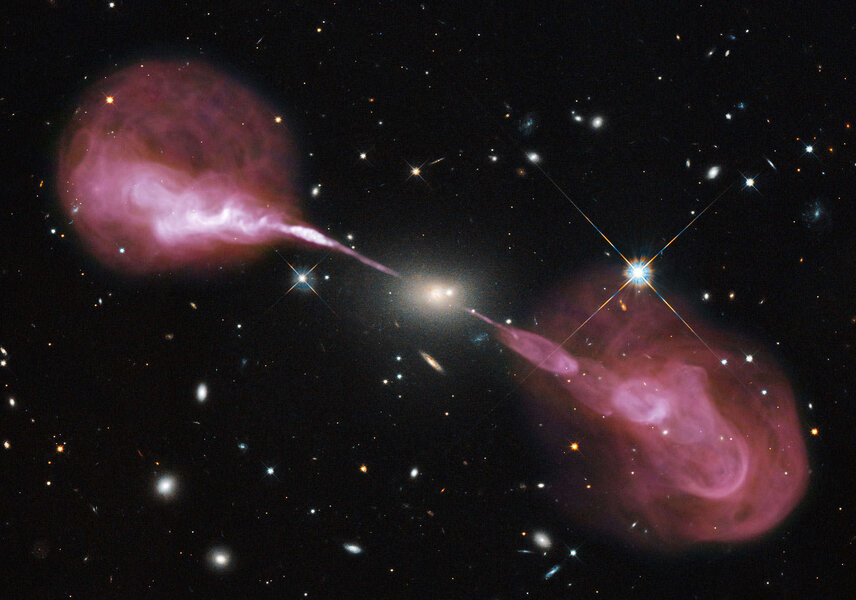Create a free profile to get unlimited access to exclusive videos, sweepstakes, and more!
How to make a blazar: Slam two galaxies together and watch them feed a huge black hole

Some galaxies aren’t quiet like ours. Instead, they blaze out vast amounts of energy from their cores. We call these active galaxies.
Every big galaxy has a supermassive black hole in its center. If that black hole is actively feeding, the material falls into a disk around it, heats up hugely, and emits a lot of light. Also, magnetic fields wind up in the center like a tornado, and can launch ridiculously powerful beams of energy away from the disk, up and down. Astronomers call these jets.
Jets can be immensely bright, and if one is aimed right at us they swamp the light from the rest of the galaxy. We see very high-energy gamma rays from these jets, as well as lots of radio waves and X-rays. We call these galaxies blazars.
But why are some galaxies like this? For a long time it’s been supposed that if two galaxies collide, the event can send huge waves of gas down into the centers of the galaxies where the supermassive black hole waits, which then triggers the activity. But with blazars it’s hard to tell because the jets are so bright.
But now, for the first time, it looks like astronomers have found some pretty good evidence: A blazar undergoing a collision with another galaxy. Even better, the jet appears to be far younger than the merger, implying the merger triggered the jet activity.
The blazar galaxy is called TXS 2116−077 (after the Texas Radio Survey and its coordinates on the sky). It’s pretty far away: about 4.2 billion light years, so a fair bit across the Universe. That makes it very faint, but not beyond the reach of some of the Earth’s biggest telescopes.
Astronomers used the huge 8.2-meter Subaru telescope to take a look at it, and found that it’s not one but two galaxies! Their centers are separated by only about 40,000 light years, smaller than the galaxies themselves. That’s pretty good evidence they’re colliding. Follow-up observations were then made with the even huger 10.4-meter Gran Canaria telescope to get spectra (breaking the light up into individual colors to get information about the galaxies’ environments) and the space-based Chandra X-Ray Observatory to get diagnostics on the jet.
They were able to get some stats on the galaxies; the blazar has about 100 billion times the Sun’s mass worth of stars in it — comparable to our own Milky Way — and the second galaxy about a fifth that much. It turns out both galaxies are active, though the small one is much weaker. Judging from various characteristics of the spectra, they find the small galaxy has a supermassive black hole with 4 million times the Sun’s mass (by coincidence, the same as Sgr A*, the one in the Milky Way), but the blazar’s black hole is a much heftier 30 million. Much larger ones are known, but that’s still impressive.
They were also able to estimate how long the merger has been going on, and get a timescale of 500 million to 2 billion years. That means the galaxies have been at it a while and are nearing the end of the process.
The jet has some interesting characteristics. It’s relatively weak as jets go: It’s putting out a mere one billion times the Sun’s energy. I mean, ho hum. Or, without the sarcasm, <running around screaming incoherently>.
But what’s so very interesting is the age of the jet, which can be estimated by its velocity (very close to the speed of light) and length: They find it’s roughly 15,000 years old. That’s incredibly young!
But it also implies that the merger process is finally dumping enough material jostled by the collision down into the blazar’s core, where it can feed the beast; it piles up into that disk which focuses the jets. By the way, we know that mergers can trigger star birth too, and the galaxy does exhibit an elevated (though not extremely so) rate. So that fits as well.
All in all this is a nice discovery. It strongly supports the idea that collisions and mergers trigger the core activity in a galaxy that produces a blazar. It may not be hard proof, but it’s at least very provocative, and honestly it’s the way I’d bet.




























